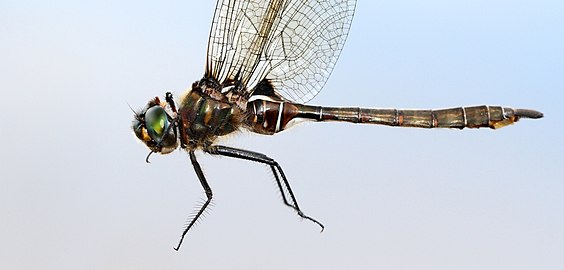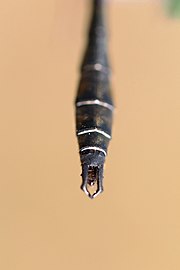Somatochlora septentrionalis
Appearance
| Somatochlora septentrionalis | |
|---|---|

| |
| male | |
| Scientific classification | |
| Domain: | Eukaryota |
| Kingdom: | Animalia |
| Phylum: | Arthropoda |
| Class: | Insecta |
| Order: | Odonata |
| Infraorder: | Anisoptera |
| Family: | Corduliidae |
| Genus: | Somatochlora |
| Species: | S. septentrionalis
|
| Binomial name | |
| Somatochlora septentrionalis (Hagen, 1861)
| |
| Synonyms[3] | |
| |
Somatochlora septentrionalis, the muskeg emerald, is a species of dragonfly in the family Corduliidae. It is endemic to Canada, where it is found from Yukon and British Columbia east to Nova Scotia and Newfoundland.[2]
Description
[edit]Adult muskeg emeralds are 39–48 mm (1.5–1.9 in) long.[4] The body is metallic green, brown and black, with a faint yellow spot on the thorax. This species is identical to Whitehouse's emerald (Somatochlora whitehousei) except in the shape of the male cerci and the female subgenital plate.[4]
-
female
-
male cerci
Life History
[edit]Muskeg emeralds occur in open fens with pools of open water. Males patrol over the pools, and females lay eggs by tapping in the open water and in floating vegetation.[4] Adults fly from June to August.[4]
References
[edit]- ^ Paulson, D.R. (2017). "Somatochlora septentrionalis". IUCN Red List of Threatened Species. 2017: e.T50978905A65836334. doi:10.2305/IUCN.UK.2017-3.RLTS.T50978905A65836334.en. Retrieved 29 August 2024.
- ^ a b "Somatochlora septentrionalis". NatureServe Explorer. NatureServe. Retrieved 26 February 2020.
- ^ Paulson, D.; Schorr, M.; Abbott, J.; Bota-Sierra, C.; Deliry, C.; Dijkstra, K.-D.; Lozano, F. (2024). "World Odonata List". OdonataCentral, University of Alabama.
- ^ a b c d Paulson, Dennis (2011). Dragonflies and Damselflies of the East. Princeton, New Jersey: Princeton University Press. pp. 351–352.




